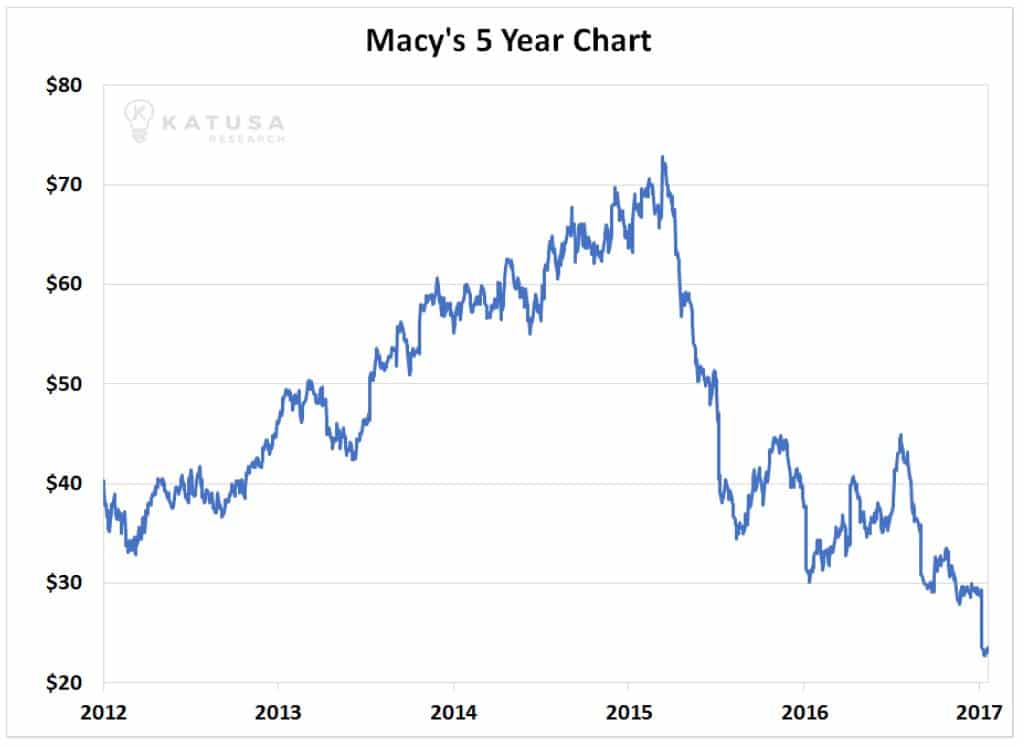One of the most fascinating things about the age we’ve living in is how the “rate of change” (or ROC) is increasing.
Driven by huge increases in computing power, technology is advancing at an exponential rate. This not only means that conventional change is occurring… but the rate at which it is occurring is speeding up.
Depending on where you stand, this is either thrilling and lucrative… or confusing and harmful.
For example, think about ride-sharing service Uber. Uber caused massive change in an entrenched industry in just a few years.
One day, the taxi business is big and powerful. The next day, it’s road kill.
You also have Netflix gutting movie-rental chain Blockbuster in just a few years.
Those kind of tectonic industry shifts used to take a lot longer to play out. Sometimes decades.
Retail stocks are another recent example of how seemingly stable and dominant entities can lose their power and value in a very short time. Amazon and other online businesses are killing many retailers.
Of course, Amazon has been Amazon for a long time. It’s been eating into bricks and mortar for a long time.
But the speed at which retail stocks have been falling over the past 24 months is incredible.
One day, you’re big bad Macy’s. You’re the retailer people say is the “best of breed.” You have your own Thanksgiving parade. Your share price is in a steady uptrend and just hit $65.
Less than two years later, you’re in shambles. Your share price is $23.
Again, depending on where you stand, the fact that seemingly powerful companies and industries are getting demolished in a few years is great news or bad news. If you don’t like to change with the times or learn new skills, then you’re in trouble. But if you’re willing to learn and look out for these changes, you can make a lot of money in a very short amount of time.
As the taxi business was crippled, early Uber investors made fortunes. Netflix is up 990% since it went public. Netflix founder Reed Hastings is a billionaire.
Of course, you don’t read Katusa Research for commentary on Silicon Valley. But as a resource investor, you should know how rapid changes in technology can make or break your portfolio. Yes, technology is bringing incredible change to the “old school” industries like mining and oil.
For example, the introduction of fracking technology has increased energy production so much that the price of natural gas fell from $5.82 to $1.61 per MMBtu in just over six years. This crushed natural gas stocks. Since coal is competitive to natural gas in the electrical power generation industry, coal and coal companies plummeted in price as well. The bluechip coal producer Peabody Energy went bankrupt.
The rapid deployment of fracking technology has supercharged oil production in the US. And the rest of the world’s top oil producing nations are taking notice.
Take a look at the oil production numbers in the US. This kind of output has not been seen in a generation.
And now take a look at how fracking is accelerating the oil production numbers in the US.
This produced such a dramatic effect on the oil market (and oil price) that in the spring of 2016 – for the first time ever – more oil was produced from fracked wells than from traditional oil wells.
The variable that best exemplifies what technology can do to oil production is the new well production per rig. This variable measures the quantity of oil that is produced from a new well, per drilling rig.
The chart below shows how wells in the Permian Basin in the United States went from producing under 100 barrels per day to nearly 700 barrels per day.
Major oil countries will apply technology that has had hundreds of billions of dollars used to advance the technology. Countries like Saudi Arabia and China will be fracking.
Fracking took time to develop and accelerate to the level it’s at today. It will take time for other countries to experience the same rate of change of fracking technology – but it will come.
The only difference is this: the countries that are new to this technology will have the benefit of decades of North American innovation, investment, and experience to lean on.
In fact, in Saudi Aramco’s Spring Technology Issue, it highlighted the increased use of frac stages, fracturing fluids, proppant and well completion designs in a recent test well. Unsurprisingly, it was the best test well reported to date. The test well had 7 frac stages. For comparison, companies in the Permian basin now drill wells with 20 frac stages.
In 2008, the average Bakken well in 2008 had a 7 stage frac design. Saudi Arabia is 9 years behind in this technological revolution.
While initial production wells in the Middle East are kept as secret as the US nuclear codes, rough production numbers indicate initial onshore production rates of 4,000 plus barrels per day. If we apply Permian Basin new oil well production growth rates to Middle Eastern wells, it is not unthinkable that these new wells will produce over 7,500 barrels per day.
And by 2040, I expect that Saudi Arabia will produce 25% of their oil from shale.
Before you invest another dollar in the resource market, ask yourself, “Will the increasing rate of technological progress help or hurt my investment?” The answer could cost or make you a lot of money… faster than you think.
-Marin








